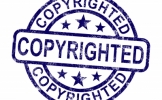 |
| (Image courtesy of Stuart Miles / FreeDigitalPhotos.net) |
After reading my last article on copyright law for artists, you may have determined that your latest creation is protected by copyright. But I hear you thinking, "What does that mean? And what else do I need to do to protect myself?" Here's how to register for copyright protection, if your work is indeed protected.
In the United States, the general rule is that you automatically own the copyright to your work as soon as you create something eligible for copyright protection. Of course, I wouldn't have a job if there weren't exceptions to this rule. The most common exceptions occur when the creator is an employee or the creator is working under a work for hire agreement. As long as you don't fall in one of the exceptions, no action is required to own the copyright in your work.
However, it is often wise to register the copyright in your work with the U.S. Copyright Office.
I like to explain to my clients that, under copyright law for artists, a copyright registration gives me a strong weapon to take into the fight when your work is stolen. That weapon is the fact that the thief will have to pay your attorneys' fees and has to pay you between $200 and $150,000 for the theft. Often, sending a letter to the thief informing them of this and including the copyright registration certificate is enough to get the thief offering a reasonable settlement. However, in order to gain this distinct advantage you must register your copyright within three months of publication or prior to the theft.
Without a copyright registration, you are responsible for paying your attorney and the maximum monetary award is the money that you lost due to the theft (e.g. your usual licensing fee) plus any profits that the thief made. Often, registration makes or breaks whether an artist can afford to pursue an infringement matter.

How To Build an Artist Website
Sign up for our newsletter and get the book How to Build an Artist Website for free!
OK, you've convinced me. How do I do it?
Learning how to register for copyright protection is easy. There are just three steps to registration: fill out the form, pay, and upload your work. And I bet you that you can do it in less than one hour.
Just a slight warning: the U.S. Copyright Website does not have the best design or layout. It was probably built 10 years ago (and hasn't been updated since) so just be patient with its idiosyncrasies.
Part 1: Fill out the Copyright Office Form
To fill out the form, you'll point your web browser to the Electronic Copyright Office. Since I'm sure that many of you are visual learners, you can follow the steps and which buttons to click using the U.S. Copyright Office Tutorial for Completing Your Electronic Copyright Registration. After creating an account you'll fill out the form.
A couple of helpful hints as you work through the form:
- If you are not sure if the work is published, read this guide by the Copyright Office.
- Any time you see the "Add Me" button, the information you entered to create your account is automatically entered and will save you from typing the information again.
- You should be both the author and the copyright claimant, unless you transferred the copyright to another party through a written agreement.
- You can skip the Limitation of Claim screen unless you incorporated material from the public domain, an earlier work of yours, or another's work.
- Any box on the Special Handling screen should only be filled out if you need Special Handling, otherwise skip this screen.
Part 2: Pay the Copyright Office
Now, you just have to fork over the cash to the U.S. Copyright Office by providing the requested payment information.
Part 3: Upload Your Work
The final step requires that you upload the files you want to submit to the U.S. Copyright Office. It often is easiest to group all the files you want to upload into a single .zip file prior to attempting the upload.
That's it! Registering your copyright is a simple process. Now that you know how to register for copyright protection, you've given yourself the ability to defend your work under copyright law for artists if (or when) someone steals it.
(I'm a lawyer, so my insurance carrier likes me to use disclaimers. The information in this post is made available for educational purposes only, not to provide specific legal advice. I am not your attorney and this post is not a substitute for competent legal advice from a licensed attorney in your state.)

Guest poster Kiffanie Stahle lives in San Francisco and is the founding partner of Stahle Law, where she provides copyright and trademark services to creatives of all kinds. She tries to make law a little less scary by giving her clients the tools they need to understand their legal rights and when to get assistance rather than forging ahead on their own. She loves to take photographs and occasionally will show them in public.




